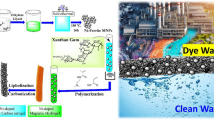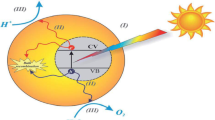Abstract
This work reported the preparation of amorphous MoSx aerogel and MoSx/carbon nanotubes composite aerogels by a modified epoxide addition sol–gel method. In this process, propylene epoxide scavenged the protons from a S–H-contained organic acid (dl-Mercaptosuccinic acid) and promoted the interactions between (NH4)6Mo7O24•4H2O and the functional groups in the organic acid to form a gel. The sulfur and molybdenum contained a wet gel turned into an amorphous MoSx aerogel after supercritical drying in ethanol. Carbon nanotubes can be further incorporated into the aerogel backbone, which can extend the specific surface area and alter the pore structures in the composite aerogels. Such composite aerogels showed good catalytic performance in electrochemical hydrogen evolution reactions.

MoSx aerogels can be prepared by the modified epoxide-adding method and showed good catalytic activity toward HER.
Highlights
-
Epoxide addition method has been adopted to synthesize amorphous molybdenum sulfide aerogel.
-
High surface area (up to 265.5 m2/g) and the developed pore structure (pore volume up to 0.89 cm3/g) have been achieved.
-
Low overpotential and high activity toward hydrogen evolution have been observed.







Similar content being viewed by others
References
Li Y, Wang H, Xie L, Liang Y, Hong G, Dai H (2011) MoS2 nanoparticles grown on graphene: an advanced catalyst for the hydrogen evolution reaction. J Am Chem Soc 133(19):7296–7299. https://doi.org/10.1021/ja201269b
Meng FK, Li JT, Cushing SK, Zhi MJ, Wu NQ (2013) Solar hydrogen generation by nanoscale p-n junction of p-type molybdenum disulfide/n-type nitrogen-doped reduced graphene oxide. J Am Chem Soc 135(28):10286–10289. https://doi.org/10.1021/ja404851s
An Y-R, Fan X-L, Luo Z-F, Lau W-M (2017) Nanopolygons of monolayer MS2: best morphology and size for HER catalysis. Nano Lett 17(1):368–376. https://doi.org/10.1021/acs.nanolett.6b04324
Jaramillo TF, Jørgensen KP, Bonde J, Nielsen JH, Horch S, Chorkendorff I (2007) Identification of active edge sites for electrochemical H2 evolution from MoS2 nanocatalysts. Science 317(5834):100–102. https://doi.org/10.1126/science.1141483
Hinnemann B, Moses PG, Bonde J, Jørgensen KP, Nielsen JH, Horch S, Chorkendorff I, Nørskov JK (2005) Biomimetic hydrogen evolution: MoS2 nanoparticles as catalyst for hydrogen evolution. J Am Chem Soc 127(15):5308–5309. https://doi.org/10.1021/ja0504690
Xie J, Zhang J, Li S, Grote F, Zhang X, Zhang H, Wang R, Lei Y, Pan B, Xie Y (2013) Controllable disorder engineering in oxygen-incorporated MoS2 ultrathin nanosheets for efficient hydrogen evolution. J Am Chem Soc 135(47):17881–17888. https://doi.org/10.1021/ja408329q
Lai C, Zhou Z, Zhang L, Wang X, Zhou Q, Zhao Y, Wang Y, Wu X-F, Zhu Z, Fong H (2014) Free-standing and mechanically flexible mats consisting of electrospun carbon nanofibers made from a natural product of alkali lignin as binder-free electrodes for high-performance supercapacitors. J Power Sources 247:134–141. https://doi.org/10.1016/j.jpowsour.2013.08.082
Park HS, Han SB, Kwak DH, Lee GH, Choi IA, Kim DH, Ma KB, Kim MC, Kwon HJ, Park KW (2017) Sulfur‐doped porphyrinic carbon nanostructures synthesized with amorphous MoS2 for the oxygen reduction reaction in an acidic medium. ChemSusChem 10(10):2202–2209. https://doi.org/10.1002/cssc.201700147
Zhao Y, Xie X, Zhang J, Liu H, Ahn H-J, Sun K, Wang G (2015) MoS2 nanosheets supported on 3D graphene aerogel as a highly efficient catalyst for hydrogen evolution. Chem – A Eur J 21(45):15908–15913. https://doi.org/10.1002/chem.201501964
Qi Y, Xu Q, Wang Y, Yan B, Ren Y, Chen Z (2016) CO2-induced phase engineering: protocol for enhanced photoelectrocatalytic performance of 2D MoS2 nanosheets. ACS Nano 10(2):2903–2909. https://doi.org/10.1021/acsnano.6b00001
Worsley MA, Shin SJ, Merrill MD, Lenhardt J, Nelson AJ, Woo LY, Gash AE, Baumann TF, Orme CA (2015) Ultralow density, monolithic WS2, MoS2, and MoS2/graphene aerogels. ACS Nano 9(5):4698–4705. https://doi.org/10.1021/acsnano.5b00087
Long H, Harley-Trochimczyk A, Pham T, Tang Z, Shi T, Zettl A, Carraro C, Worsley MA, Maboudian R (2016) High surface area MoS2/graphene hybrid aerogel for ultrasensitive NO2 detection. Adv Funct Mater 26(28):5158–5165. https://doi.org/10.1002/adfm.201601562
Long H, Chan L, Harley-Trochimczyk A, Luna LE, Tang Z, Shi T, Zettl A, Carraro C, Worsley MA, Maboudian R (2017) 3D MoS2 aerogel for ultrasensitive NO2 detection and its tunable sensing behavior. Adv Mater Interfaces 4(16):1700217. https://doi.org/10.1002/admi.201700217
Li N, Chai Y, Dong B, Liu B, Guo H, Liu C (2012) Preparation of porous MoS2 via a sol–gel route using (NH4)2Mo3S13 as precursor. Mater Lett 88:112–115. https://doi.org/10.1016/j.matlet.2012.08.031
Guo X, Wang Z, Zhu W, Yang H (2017) The novel and facile preparation of multilayer MoS2 crystals by a chelation-assisted sol-gel method and their electrochemical performance. RSC Adv 7(15):9009–9014. https://doi.org/10.1039/C6RA25558B
Guo X, Yin P, Wang Z, Yang H (2018) Template-assisted sol–gel synthesis of porous MoS2/C nanocomposites as anode materials for lithium-ion batteries. J Sol-Gel Sci Technol 85(1):140–148. https://doi.org/10.1007/s10971-017-4531-8
Arachchige IU, Armatas GS, Biswas K, Subrahmanyam KS, Latturner S, Malliakas CD, Manos MJ, Oh Y, Polychronopoulou K, P. Poudeu, Trikalitis PF, Zhang PN, Zhao Q, Peter SC L-D (2017) Mercouri G. Kanatzidis: excellence and innovations in inorganic and solid-state chemistry. Inorg Chem 56(14):7582–7597. https://doi.org/10.1021/acs.inorgchem.7b00933
Doan-Nguyen VVT, Subrahmanyam KS, Butala MM, Gerbec JA, Islam SM, Kanipe KN, Wilson CE, Balasubramanian M, Wiaderek KM, Borkiewicz OJ, Chapman KW, Chupas PJ, Moskovits M, Dunn BS, Kanatzidis MG, Seshadri R (2016) Molybdenum polysulfide chalcogels as high-capacity, anion-redox-driven electrode materials for Li-ion batteries. Chem Mater 28(22):8357–8365. https://doi.org/10.1021/acs.chemmater.6b03656
Subrahmanyam KS, Malliakas CD, Sarma D, Armatas GS, Wu J, Kanatzidis MG (2015) Ion-exchangeable molybdenum sulfide porous chalcogel: gas adsorption and capture of iodine and mercury. J Am Chem Soc 137(43):13943–13948. https://doi.org/10.1021/jacs.5b09110
Islam SM, Subrahmanyam KS, Malliakas CD, Kanatzidis MG (2014) One-dimensional molybdenum thiochlorides and their use in high surface area MoSx chalcogels. Chem Mater 26(17):5151–5160. https://doi.org/10.1021/cm5024579
Staszak-Jirkovský J, Malliakas Christos D, Lopes Pietro P, Danilovic N, Kota Subrahmanyam S, Chang K-C, Genorio B, Strmcnik D, Stamenkovic Vojislav R, Kanatzidis MG, Markovic NM (2015) Design of active and stable Co–Mo–Sx chalcogels as pH-universal catalysts for the hydrogen evolution reaction. Nat Mater 15:197. https://doi.org/10.1038/nmat4481
Gao Q, Wang X, Shi Z, Ye Z, Wang W, Zhang N, Hong Z, Zhi M (2018) Synthesis of porous NiCo2S4 aerogel for supercapacitor electrode and oxygen evolution reaction electrocatalyst. Chem Eng J 331:185–193. https://doi.org/10.1016/j.cej.2017.08.067
Gao Q, Shi Z, Xue K, Ye Z, Hong Z, Yu X, Zhi M (2018) Cobalt sulfide aerogel prepared by anion exchange method with enhanced pseudocapacitive and water oxidation performances. Nanotechnology 29(21):215601
Gash AE, Tillotson TM, Satcher JH, Poco JF, Hrubesh LW, Simpson RL (2001) Use of epoxides in the sol−gel synthesis of porous iron (III) oxide monoliths from Fe (III) salts. Chem Mater 13(3):999–1007. https://doi.org/10.1021/cm0007611
Klimova TE, Valencia D, Mendoza-Nieto JA, Hernández-Hipólito P (2013) Behavior of NiMo/SBA-15 catalysts prepared with citric acid in simultaneous hydrodesulfurization of dibenzothiophene and 4,6-dimethyldibenzothiophene. J Catal 304:29–46. https://doi.org/10.1016/j.jcat.2013.03.027
Du A, Zhou B, Zhong Y, Zhu X, Gao G, Wu G, Zhang Z, Shen J (2011) Hierarchical microstructure and formative mechanism of low-density molybdena-based aerogel derived from MoCl5. J Sol-Gel Sci Technol 58(1):225–231. https://doi.org/10.1007/s10971-010-2381-8
Du A, Zhou B, Zhang Z, Shen J (2013) A special material or a new state of matter: a review and reconsideration of the aerogel. Materials 6(3):941–968
Wanger CD, Riggs WM, Davis LE, Moulder JF, Muilenberg GE (1979) Handbook of X ray photoelectron spectroscopy. Perkin‐Elmer Corp, Eden Prairie, Minnesota, USA
Wang HW, Skeldon P, Thompson GE (1997) XPS studies of MoS2 formation from ammonium tetrathiomolybdate solutions. Surf Coat Technol 91(3):200–207. https://doi.org/10.1016/S0257-8972(96)03186-6
Benck JD, Chen Z, Kuritzky LY, Forman AJ, Jaramillo TF (2012) Amorphous molybdenum sulfide catalysts for electrochemical hydrogen production: insights into the origin of their catalytic activity. ACS Catalysis 2(9):1916–1923. https://doi.org/10.1021/cs300451q
Vrubel H, Moehl T, Gratzel M, Hu X (2013) Revealing and accelerating slow electron transport in amorphous molybdenum sulphide particles for hydrogen evolution reaction. Chem Commun 49(79):8985–8987. https://doi.org/10.1039/C3CC45416A
Du A, Zhou B, Shen J, Xiao S, Zhang Z, Liu C, Zhang M (2009) Monolithic copper oxide aerogel via dispersed inorganic sol–gel method. J Non-Cryst Solids 355(3):175–181. https://doi.org/10.1016/j.jnoncrysol.2008.11.015
Bi Y, Ren H, Chen B, Chen G, Mei Y, Zhang L (2012) Synthesis monolithic copper-based aerogel with polyacrylic acid as template. J Sol-Gel Sci Technol 63(1):140–145. https://doi.org/10.1007/s10971-012-2777-8
Kido Y, Nakanishi K, Miyasaka A, Kanamori K (2012) Synthesis of monolithic hierarchically porous iron-based xerogels from iron(III) salts via an epoxide-mediated sol–gel process. Chem Mater 24(11):2071–2077. https://doi.org/10.1021/cm300495j
Bi YT, Ren HB, Chen BW, Zhang L (2011) Synthesis and characterization of nickel-based monolithic aerogel via sol-gel method. Adv Mater Res 335-336:368–371. https://doi.org/10.4028/www.scientific.net/AMR.335-336.368
Acknowledgements
This work is supported by the National Key Research and Development program (grant no. 2016YFB0901600) and NSCF (grant no. 21303162 and grant no. 11604295).
Author information
Authors and Affiliations
Corresponding author
Ethics declarations
Conflict of interest
The authors declare that they have no conflict of interest.
Ethical statement
I certify that this paper is original and has not been published and will not be submitted elsewhere for publication while being considered by Journal of Sol–Gel Science and Technology. And the study is not split up into several parts to increase the quantity of submissions and submitted to various journals or to one journal over time. No data have been fabricated or manipulated (including images) to support our conclusions. No data, text, or theories by others are presented as if they were the authors’ own. The submission has been received explicitly from all co-authors. And authors whose names appear on the submission have contributed sufficiently to the scientific work and therefore share collective responsibility and accountability for the results.
Rights and permissions
About this article
Cite this article
Gao, Q., Jin, Y., Jin, Y. et al. Synthesis of amorphous MoSx and MoSx/carbon nanotubes composite aerogels as effective hydrogen evolution reaction catalysts. J Sol-Gel Sci Technol 88, 227–235 (2018). https://doi.org/10.1007/s10971-018-4793-9
Received:
Accepted:
Published:
Issue Date:
DOI: https://doi.org/10.1007/s10971-018-4793-9




